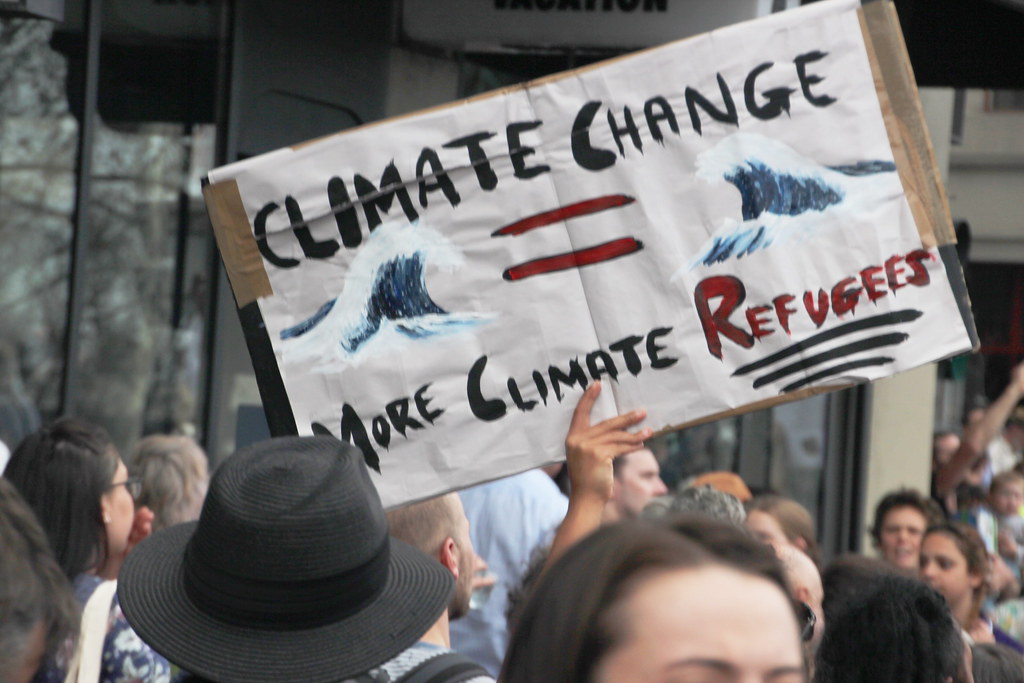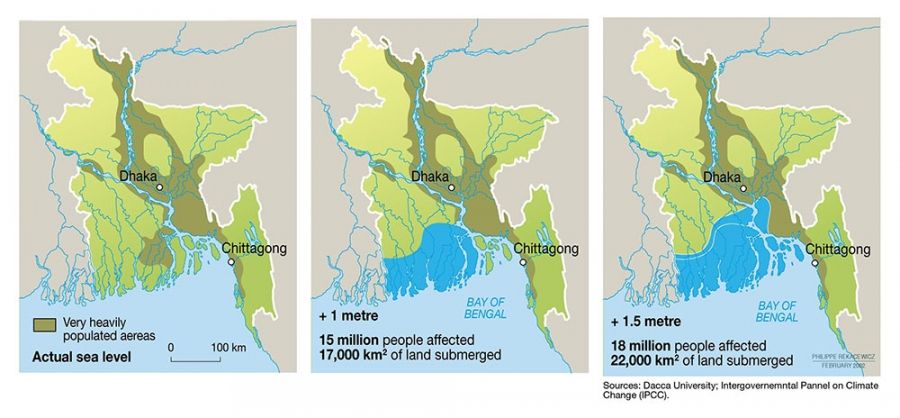The annual displacement of millions of persons around the globe due to environmental disasters must be addressed. More and more individuals are facing droughts, famines, floods, fires and so on, of increasing intensity. They just must leave the place they call home, for a better future. The journey is often uncertain, characterized by crossings in risky and unstable areas. Even once they arrive in the host country, they are often relegated to the margins of society, discriminated against and without the possibility of being recognized as refugees because they are not covered by the 1951 Refugee Convention.

Climate change is awaited to displace large populations from rural to urban areas, affecting vast already vulnerable sections of humankind. Heat and irregular rainfall will ruin many agricultural lands and contribute to land degradation, the advancement of deserts, food insecurity, and permanent alteration of many regional economic systems. In this context, a new character is coming to light, the one called ‘Climate refugee’, those who move due to natural disasters and climate change. The International Organization for Migration (IOM) estimates that there could be as many as 200 million such refugees by 2050. The worst scenario predicts that almost one-third of the global population will live in extremely hot climates, currently located in less than 1% of the earth’s surface mainly in the Sahara. At this point, migration is an evolutionary strategy to afford the changing climate and not just a case of instability. The drivers of migration are complex and there is now rising acknowledgement that climate change is a threat multiplier, that can significantly intensify the conditions that lead to conflict, destitution, and displacement. In recent decades, however, the international replies to migration have become much less welcoming, requiring large swathes of people to undertake uncertain and often fatal journeys by road or by sea to find a route into some country that might host them.
Humanity is already living through a lot of these difficult situations, such as migration and conflict related to climate change and resulting agricultural and ecological problems are increasingly issuing in the Sahel, a semi-arid region stretching across Africa from Ethiopia to Senegal. Smallholder rainfed agriculture and herding are becoming increasingly difficult due to the irregular availability of water and in some location’s expansion of the Sahara Desert. Many people facing unpredictable weather, food insecurity, and in some cases violence, have left their land for urban centers in African nations, where conflict with living populations and discord over space and essentials may occur. Others have followed longer, more dangerous migration routes across the Sahara and the Mediterranean in dreams of reaching Europe. These routes are characterized by conflict with populations and governments along migration routes and substantial hazards during transport across the desert and ocean. Even after arrival in host countries, migrants remain a cause of serious political tension and experience a variety of forms of discrimination and violence.
Most of the research suggests that a continued drought linked to climate change has contributed to civil strife in Syria. In 2011, around one million people migrated to the urban centres, including the seat of the Assad government in Damascus. These urban areas were already stretched for resources by 1.5 million Iraqi refugees from previous years. Protests against the Syrian government in the spring of 2011 led quickly to outright civil war. That war has killed almost 500,000 people, generated 5.5 million refugees and at its peak 11 million internally displaced persons. The ongoing repercussions of this conflict are weakening stability in much of the Middle East as well as Europe.
In Central America, since 2009, the “Dry Corridor” in Nicaragua, Honduras, El Salvador, and Guatemala has undergone a series of devastating multi-year droughts. According to the Food and Agricultural Organization (FAO) of the United Nations, crop losses in the region from 2006 to 2016 range from 50 to 90% and left 3.5 million people in need of humanitarian assistance. Facing uncertainty about future rainfall, many have chosen to leave, with emigration from the region increasing by 500% between 2010 and 2015. Most people travelled overland along this “dry” corridor to seek better chances northwards. This trek has resulted in increasing conflict between migrants and authorities in transit nations and along the southern border of the USA.
The densely populated Gangetic, in South Asia also drop in the zone that will experience high temperatures because of climate change in the coming decades, expected to exceed 35 °C. Besides, Bangladesh will face the consequences of rising sea levels and coastal flooding that is already exposing millions of coastal dwellers. The population is highly dependent on the summer monsoons and rainfed agriculture, making it particularly vulnerable to temperature and rainfall changes. The region is likely to have the highest number of food-insecure people by mid-century. Coastal cities such as Mumbai, Dhaka, and Chennai are likely to reel under the burden of continued rural to urban migration, until intensifying heat, and worsening flooding and coastal storm surges make life untenable for most of the millions who live at the economic margins of these megalopolises, forcing them to move again.

Rising religious and ethnic intolerance in South Asia does not bode properly for the region when the overwhelming survival need for populations in this century will be more movement not less. Rohingya refugees from Myanmar are confined in what is now the world’s largest refugee camp in coastal Cox’s Bazar in Bangladesh, where they are denied formal refugee status, and remain stateless, unable to seek formal work, advance educational opportunities, or do much more than barely survive. In India, the government attacked its minorities by arresting dissenters and beginning to build detention camps for Muslims and unregistered populations in the northeast of the country near Bangladesh, a likely source of climate refugees, is now heavily militarized.
At present, available testimony indicates that crisis migration from climate pressures does sometimes lead to intense social conflict and in certain cases contributes directly to armed conflict. Most migration will continue to occur within countries, and will mostly involve rural to urban population flows, mediated by a complex intersection of political, demographic, socioeconomic, and environmental drivers. While transient illnesses like the nationwide lockdown in India amidst the COVID-19 pandemic resulted in return migration to rural areas, the current literature suggests overwhelming net rural to urban migration. It recognized that the cities hosting these migrants were also particularly exposed to environmental change and without enough preparation would also suffer the consequences of extreme heat and depleted water resources. The migration in the Dry Corridor heading toward the US border, or the dangerous journeys over the Mediterranean, are examples of migration patterns when the first stop of refuge is no longer a sustainable option. The wall-building, xenophobic, and insular strategy embraced by the USA, Europe, China, and India to deal with the greatest challenge of our times is regressive, violent, and deeply ignorant, in that it denies the core reality that for millennia, under threat, humans have moved to escape. the 2020 pandemic has reaffirmed that the current global strategy to face obstinate challenges does not embrace cooperation, mutual interest, and scientific rigour but instead retreats to the inflexible rejection of a future that is upon us. Unless the most powerful governments around the world change their way of acting, the evidence shows, the impact of climate change on the hundreds of millions who will nevertheless move, on those in regions that will receive them, and on those who will not find any remedy through migration, will be impossible to bear.
There is a gap in the protection of ‘climate refugees’, who are neither clearly defined as a category nor covered by the 1951 Refugee Convention. The latter hugs only people who have been persecuted on territories related to race, religion, nationality or membership of a particular social group or political opinion, and are unable or unwilling, owing to fear of persecution, to seek protection from their home countries. This definition does not concern people displaced for reasons due to climate change, as it would be difficult to consider environmental degradation as ‘persecution’ in the sense followed by the Refugee Convention. This means that the estimated 200,000 Bangladeshis, who become homeless each year due to river-bank erosion, cannot easily request resettlement in another country. In the future, climate changes could have huge effects on many populations, mainly those in coastal and low-lying areas such as Vietnam, the Netherlands, and certain parts of the US. The focus issue here must face with the effectiveness of rights. Where there are no legal terms for an individual right because the status quo is not embraced by the law, then the individual cannot be guaranteed international protection as law.
Sources
· https://www.unhcr.org/climate-change-and-disasters.html
· https://www.europarl.europa.eu/RegData/etudes/BRIE/2018/621893/EPRS_BRI(2018)621893_EN.pdf
· https://www.unhcr.org/protection/environment/5fb28b504/climate-change-future-safe-returns.html
· Balsari, S.; Dresser, C.; Leaning, J. Climate Change, Migration, and Civil Strife. Curr. Environ. Heal. Reports 2020, 7, 404–414, doi:10.1007/s40572-020-00291-4

